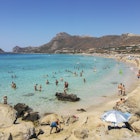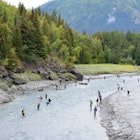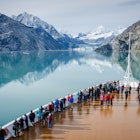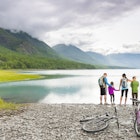

The shoreline on Fox Island, Alaska. Alexander Howard / Lonely Planet
Covered in impenetrable forests and lined with craggy coastlines, Alaska has achieved almost a mythic status as the Last Frontier – a land of hardy explorers and off-the-grid adventurers, raw wilderness and crevasse-cut glaciers. But how easy is it to get a sense of the call of the wild that draws so many people to this state? To find out, I followed in the footsteps of the American artist Rockwell Kent, whose urge to explore led him to live in a cabin on a barely inhabited island off the coast of Alaska, 100 years ago.
A light rain falls as I disembark the ferry from the mainland town of Seward, Alaska, and step down the gangway to the black-pebble beach. Twin peaks bracket the shore, forming a protected cove lined with spruce. Driftwood is scattered along the waterline like matchsticks. This is Fox Island, Alaska, my home for the next few days. Just under three and a half miles in length, and barely a mile wide, the island is a dot in the fjords and bays that line southern Alaska’s Kenai Peninsula.
One hundred years before my arrival, the American painter Rockwell Kent came to Fox Island with his nine-year-old son. His plan: to work on his paintings while having a ‘quiet adventure in the wilderness’, as he wrote in his journals, published a few years later under the title Wilderness. I’m here to find out what first brought Kent into the wilderness, and what continues to draw a steady trickle of people to this part of Alaska.
To get a higher vantage point, I hike up to a ridge strung between the island’s mountains like a hammock. Dewy ferns and sponge-like moss blanket the forest floor. Magpies chatter in the trees. After an hour on the muddy trail, I stop at the top of a 400-foot cliff. Through the bramble, I see the peaks that form the southwestern border of the Chugach National Forest – hard, rugged, seemingly impenetrable.
Kent felt the same tug to explore. ‘A banana peeling on a mountaintop tames the wilderness,’ he wrote. ‘Much of the glory of this Alaska is in the knowledge I have that the next bay – which I may never choose to enter – is uninhabited, that beyond those mountains across the water is a vast region that no man has ever trodden, a terrible ice-bound wilderness.’
Of course, Alaska Natives lived on the Kenai Peninsula long before solitude-seekers came to Fox Island. It’s naïve to think that Kent’s feet were the first to stand on the ridge, or that the next hiker isn’t far behind me. Still, at the top of the ridge, with the wind gusting through the trees, a person in any century can have at least a brief moment of discovery. Luckily for me, there aren’t any banana peels around.
When the weather clears, I maneuver myself into a red sea-kayak and head out into the calm waters of the cove, accompanied by a group of other paddlers and two guides. The sky is a bowl of pure blue, with just a dusting of cloud ringing the mountains across the bay. We head north along the cove, inspecting the orange starfish that cling to the rocks. As we round the headland, the waters grow rough. Waves threaten to topple the kayak, and I’m suddenly sympathetic to Kent’s plight: having just a small boat as his lifeline to Seward. We hug the cliff, seeking harbor from the deeper water. Distraction comes in the form of our first wildlife sighting: a seal on top of a seaweed-clad rock, head cocked in curiosity.
It takes almost an hour of fighting the wind and waves before we round the northern tip of Fox Island. The eastern range of mountains that line the Kenai Peninsula come into view. Blue-green peaks rise out of the turquoise water as spruce-covered slopes, recalling Kent’s illustrations: mountains captured in solid black lines with lighter strokes to indicate shadow and trees – early drafts of the paintings for which he would become famous.
Whispers of orcas pass among the passengers of my ferry from Fox Island back to Seward. It’s late in the season for whale-spotting, but rumors of their appearance in the Gulf of Alaska have passengers on the teal-painted top deck giddy with excitement.
Kent’s experiences with wildlife were mostly limited to the magpies and sparrows that darted through the trees and a family of porcupines that lived on the island. But once he recalled a pod of orcas that came within view, writing, ‘The killer-whales that early in September played in the shoal water of our cove not thirty feet from land, rolled their huge, shining bodies into view, plunged, raced where we still could follow their gleaming, white patch under water – there’s a thrill!’
When we’re fully in the Gulf of Alaska, the captain announces over the intercom that they’ve spotted a superpod of orcas, the term used when a large group of orcas come together to feed. Passengers shift to the rails on the bow. In the distance, a black dorsal fin appears on the horizon. Soon, everywhere I look there are black-bodied orcas surfacing in twos and threes. Suddenly there’s one in the air, twisting like a gymnast. Sunlight glints off its obsidian flanks, and cameras clatter in high-speed bursts. Then, as quickly as it appeared, the whale is gone, and a brief bloom of ocean water settles into the flat horizon. The crowd applauds, each of us enthralled by the adventure before us. A thrill indeed.

The final pages of Kent’s journals find him in a reflective mood. ‘It seems that we have both together by chance turned out of the beaten, crowded way and come to stand face to face with that infinite and unfathomable thing which is the wilderness,’ he writes. ‘And here we have found OURSELVES – for the wilderness is nothing else. It is a kind of living mirror that gives back as its own all and only all that the imagination of a man brings to it.’
On the deck of the ferry, I wonder if that same experience is possible here today. The air is clear, fresh with the chill of the changing season. As I look toward the mainland, a bald eagle rides a thermal above the peninsula in Resurrection Bay, circling higher over the spruce until it’s a tiny speck in the sky. Below it, a valley is studded with ice. The view is not far different to what Kent saw 100 years ago.
This article appeared in the April 2019 issue of Lonely Planet magazine.
Alexander Howard traveled to Alaska with support from Pursuit, which owns Kenai Fjords Wilderness Lodge. Lonely Planet contributors do not accept freebies in exchange for positive coverage.
Explore related stories



 National Parks4 Alaska itineraries that are made for spectacular summer adventures
National Parks4 Alaska itineraries that are made for spectacular summer adventuresMay 27, 2024 • 7 min read







